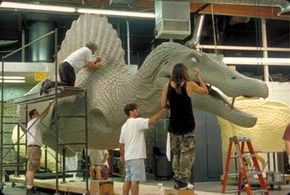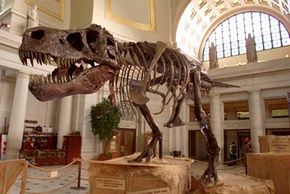On a foggy August day in 1990, Susan Hendrickson found a few fossilized dinosaur bones weathering out of a cliff on a ranch near Faith, South Dakota. The ranch belonged to Maurice Williams, who was one-quarter Sioux. Hendrickson's employer, Peter Larson, a founder of the Black Hills Institute of Geological Research at Hill City, South Dakota, was at the time en route to Faith to fix the tires on one of the Institute's vehicles. Hendrickson, driven by a feeling that she would make a great discovery, decided that morning to do some fossil prospecting on the ranch. She could tell at once that the bones visible in the cliff-a few vertebrae and a partial thigh bone-belonged to a large meat-eating dinosaur, almost certainly a Tyrannosaurus rex.
By the time she made her way back to camp, Larson had returned. She showed him a few pieces of the find. Larson agreed excitedly that she had found a Tyrannosaurus, and they began making plans to dig the bones out of the ground. They checked to make sure that Williams was indeed the owner of the land where the bones were found, and they obtained his permission to excavate to see how much of the skeleton was there. In a few days, Larson and his crew realized that they were looking at the most complete skeleton of a Tyrannosaurus rex ever discovered. More than 90 percent of the dinosaur's bones were present, including a huge skull nearly five feet long. It was also the largest Tyrannosaurus rex ever found, and its bones were especially well preserved.
Larson negotiated with Williams to buy the skeleton for $5,000 and started work. Within 17 days the skeleton was out of the ground, jacketed, and on its way to the Institute's preparation laboratory. Larson nicknamed the fossil "Sue," after Susan Hendrickson. He had a theory about how one might tell male and female meat-eating dinosaurs apart, and "Sue," he thought, was a large female.
When Williams saw the tremendous publicity the find received, both he and the Sioux tribe began to have second thoughts about the ownership of the bones. The Sioux tribe also felt that they might be legal owners of the fossil, and they asked the U.S. Government to get involved.
In the ensuing legal struggle, the FBI seized "Sue" from the Institute and locked it away at the South Dakota School of Mines and Technology in Rapid City until the dispute could be resolved. They also seized the Institute's financial and fossil-collecting records-and discovered legal irregularities that eventually placed Larson into a minimum-security federal prison for two years.
Larson never got "Sue" back. The government declared Williams the legal owner and returned the fossil to him. Williams soon contacted Sotheby's in New York City to auction the skeleton. On October 4, 1997, after a huge publicity campaign, "Sue" was sold for a mind-boggling $8.36 million to the Field Museum of Natural History in Chicago, which received corporate backing from Walt Disney World Resort and McDonald's Corporation.
The Field Museum became responsible for preparing "Sue" for public display. Head fossil preparator Bill Simpson and his team worked the bones out of the matrix, and Phil Fraley designed the mount to hold them. Paleontologist Christopher Brochu was hired to write up "Sue's" scientific description. The skull, crushed and flattened when the dinosaur was buried 67 million years ago, was CT-scanned to reveal its internal structure. Too heavy to mount with the rest of the dinosaur, the skull was replaced on the skeleton by a lightweight cast with the crushing straightened out. On May 17, 2000, "Sue" went on permanent public display in Chicago. The real skull was displayed nearby.

